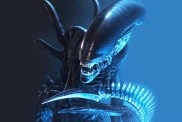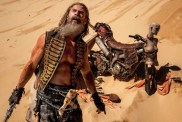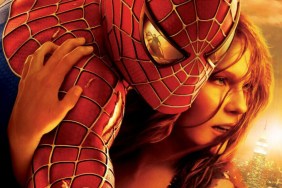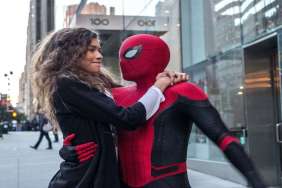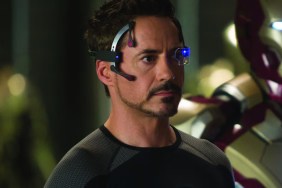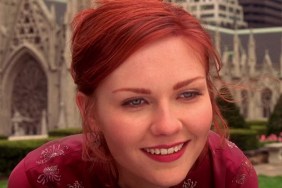
The Sony Pictures lot in Culver City, California was host this week to a special presentation of nearly 30 minutes of Marc Webb’s The Amazing Spider-Man 2, which was immediately followed by a Q&A with Webb himself. ComingSoon.net/SuperHeroHype was there and you can check out a full transcript of Webb’s thoughts about the sequel and the rapidly expanding big screen Spidey-verse beneath our footage description.
The Amazing Spider-Man 2 opens with a flashback to the same night we saw in the first film, wherein a young Peter Parker sees his parents for the final time. Richard Parker is in a hurry, racing to destroy his research (including killing test spiders with chloride gas). He sits and begins to record a video message.
“People will say I’m a monster for what I’ve done,” he begins, going on to explain that his actions will have he and his wife looking over their shoulders for the rest of their lives.
Richard and Mary Parker rush out in the middle of the night and board a private plane. Richard is trying to upload a file from his laptop when a man emerges from the cockpit and Parker notices blood on his hands. The man draws a gun and Mary hits him from behind. He turns and shoots her, but Richard is able to get, for the moment, the upper hand. Mary falls to the floor, bleeding, while Richard wrestles with the thug. He manages to get the gun and shoots a window, which immediately sucks the villain out.
With the plane diving and his wife bleeding out in front of him, Parker manages to make sure the file has uploaded just an instant before everything goes white.
Years later, we open on Spider-Man as he falls through the air above Manhattan. This is the beginning of the Rhino chase and the scene starts in media res with Paul Giamatti’s Aleksei Sytsevich having already stolen an Oscorp truck full of plutonium (he’s literally managed to steal the entire truck and is barreling through the streets with it on the back of an even larger vehicle).
Inside the car, Aleksei turns as a webbed hand comes up from below, knocking on the window. It’s Spidey, of course, with Andrew Garfield delivering joke after joke as he slows the chase down, webbing up all of Aleksei’s thugs and showing off some very well-choreographed spider-moves. There’s even one scene where Spidey, trying to prevent a case of plutonium canisters from spilling, dangles from the inside roof of the truck and makes use of his adhesive body to catch each and every one.
In the midst of this, we also meet Jamie Foxx’s Max Dillon, who is wandering through the streets with an armful of blueprints. He’s nearly killed by the speeding truck, but Spidey saves his life and gives him a quick pep talk, telling him that he needs people like Max to be his eyes and ears on the streets. Clearly, Max is moved and, as Spidey swings away, he beams with admiration.
Spidey just has Aleksei left to take down and is clinging to the front of the fast-moving vehicle when his phone rings (to a MIDI version of the classic “Spider-Man” theme). It’s Emma Stone’s Gwen Stacy, who wants to know where Peter is. He’s supposed to be graduating from high school in just minutes.
At the Midtown Science High ceremony, Gwen is the valedictorian and we hear her speech cut over Spider-Man’s battle with Aleksei. There are obvious teases at the infamous “The Night Gwen Stacy Died” issue of the original comics with the central theme being that, even if you fall, it’s important just to have lived in the first place.
Spider-Man quickly takes down Aleksei, webbing him up in the streets and pulling down the villain’s pants before racing off to graduation, making it just in time to take the stage.
The next scene picks up a full year later. Peter and Gwen haven’t seen each other but are quickly rediscovering their chemistry as they agree to be friends and joke about ground rules they need to set. She soon tells him the bad news, though: She’s moving to England as part of a research program.
Meanwhile, Max Dillon stumbles down the street. He’s now in full Electro mode, setting off car alarms and lights as he walks. We see from some POV shots that he’s drawn to power sources and looks up to see Times Square before him.
Peter barely has time to react to the news when he has to swing into action, confronting Dillon as we saw in the previously-released clip. There’s also an interesting filmic depiction of Peter’s “Spider-Sense,” showing how he’s able to process everything in slow-motion bullet time.
The final scene showcased has Dane Dehaan’s Harry Osborn breaking Electro out of Ravencroft. It’s unclear exactly what has transpired, but Harry seems to hate Peter and no longer has any control over Oscorp Industries. Dillon’s own idea was stolen by Oscorp, it seems, and Harry wants to team up to get revenge. Freed from his shackles, Electro actually demonstrates a teleportation ability as he takes down Ravencroft guards.

Q: Can you talk about some of the classic Spider-Man elements that maybe you didn’t have a chance to incorporate in the first movie that you wanted to bring to this one. The Daily Bugle, for instance, seems to be heavily featured in the marketing.
Marc Webb: Yeah, we’re developing the Daily Bugle. Obviously, you’re going to get a little hint of Norman Osborn in this film. The Daily Bugle is part of it. The big thing that I wanted to nail this time was the suit, you know? I wanted to return to the iconography that we knew from the comic books and the Daily Bugle is an emerging force to be reckoned with. That’s one of the fun things about delving into a universe like this. You can take more time with these things. We really did think about this in a longer format. As far as things like the Daily Bugle and Norman Osborn’s story, we were very selective about how to tease that out.
Q: Obviously, we got a bit of a preview of it from the footage, but I’m curious about Electro’s motivations. It seems like he’s driven by this overall need to be needed by society. Could you talk about exploring that theme and how it manifested itself?
Webb: Sure! To understand Electro is to understand Max Dillon, as Jamie [Foxx] has said. Jamie’s been a really great component of this and he was a great partner in trying to generate this in the movie. Max Dillon’s character has been sort of ignored by the world, forgotten by people. He’s an outcast, much in the way that Peter Parker is an outcast, and he chooses to react to that in a little bit different a way. There is a wonderful pathos that Jamie enables at the beginning of the film. You haven’t seen that part yet, but you really feel for him. But there’s also a psychosis. There’s something mad about him and that eventually gets the better of him.
Q: It looks like you’ve really amped up the comedy. It was certainly there in the first one, but can you talk about developing that for the sequel?
Webb: That’s one of the iconic parts of the character that we chose to embrace. Even in the first movie, there’s that scene in the parking lot. Something fundamental about Spider-Man, as you guys know, is his wit and his quips, but it’s also part of his character. It’s how he provokes villains, particularly. It’s how he puts them on their heels and I think that, with Rhino, it’s particularly convenient because he’s such a dumb villain that he can provoke in that way. We always try to think about it in the nature of the scene and the nature of the character. That’s where the comedy emerges. We did something that sometimes big comedy movies do, which is to get a roundtable of comedians and just have them spit jokes out. We’d use that and try them out with Andrew and see what worked. We would have, in the beginning of the process, ome of the best comedians. It’s sort of a private thing that you can’t really tell who’s in it, but these are amazing, really brilliant comedians and many of them are comic book fans. The come in and help us with coming up with jokes and one-liners and quips that are part of Spider-Man’s universe.
Q: It has already been said that there’s going to be a third “Amazing Spider-Man” in 2016 and an “Amazing Spider-Man 4” in 2018, plus all these spin-offs with Venom and the Sinister Six. How much are you involved with the overall Spidey universe as it is?
Webb: We — you know, myself and my partners at Sony, and Avi and Matt — we’ve been trying to figure out how to develop a larger universe and there are some very exciting things coming around the corner with “The Sinister Six” and “Venom” and future Spider-Man movies. I want to be involved in any way I possibly can and we’re already talking. We’ve had these really wonderful discussions and there’s already been some announcements, but you know Alex and Bob and Drew Goddard and a lot of these really brilliant minds who are young and emerging are helping us develop something a little bit more elaborate and exciting. It’s just been a blast. It’s sort of a dream come true. We’ve had fantasies about what we could do and they’re slowly coming to reality. I’m really excited about that.
Q: I was wondering if you could talk about the decision to have Peter and Gwen graduate from high school. It seemed like when you rebooted the franchise, part of the reason was to keep them younger.
Webb: Listen, our actors are getting a little bit older. To play around with that for too long would get to be absurd. We’re also trying to find stations in life and important moments for them to emerge from. We did spend the whole first movie in high school. This is not that much further in their future. To be honest, there’s a thematic resonance with people moving on, with graduation, which felt really potent to us. The graduation speech was a way to introduce the universe and the themes of the movie in an interesting way and that just felt right. They were getting to that age and it’s about a gradual teasing of information. It felt appropriate to watch that important moment in their lives.
Q: One criticism some people had of the first movie was how, when it was over, we still didn’t quite know what happened with Peter’s parents. Is that going to be explained more in depth in this film?
Webb: Yes. That’s the thing. It’s a tricky thing because that was part of what we were trying to establish. Of course it was going to be teased out. We had a plan about how to let that unfold. It was sort of the long shadow that was cast over Peter Parker’s life. We knew how this was going to emerge. We had ideas about the pathways of these characters, but we didn’t want to blow everything out in the first movie because, again, it’s about creating a more elaborate universe developing into more and more interesting and nuanced things that the fans are really going to enjoy.
Q: There’s a lot going on in the scenes we saw and you’re introducing a lot of characters. We see that we’re going to get a lot of backstory on a lot of people. What’s your run time looking like with all of that going on?
Webb: 16 hours! (laughs) No, it’s going to be over 2 hours, but it’s really — I actually don’t know the exact number, but we’re very careful to invest in the characters while keeping the story moving forward. There’s no one more acutely aware of that than me and I am, at times, impatient, but I also really value richness of character and that requires spending some time. I mean, there is a value to understanding the first movie, but it’s certainly not imperative to enjoying and experiencing the holistic quality of the second film
Q: Did early plans for a third and fourth film affect the script of this one at all? Webb: You know, originally it was conceived as a trilogy. We were thinking about three movies and then we started messing around with the second movie. There was such an enormous wealth of information and we were just like, ‘We can’t cram them all into one movie! There’s too much richness there!’ So when we were talking about the beginning of the second film, we were trying to plan out all of the emerging storylines. It just started to make sense to invest in other stories. Then, in particular, the Sinister Six is something we’d always talked about, just asking, ‘How do we plan this out?’ So, that’s where it started, the beginning of the second movie, in terms of developing the universe.
Q: You clearly have a plan for where you’re going. Knowing that, how and why does Electro being the main villain fit with that?
Webb: I think primarily — again, in the first film — I had sort of an idea of how these characters would evolve. I just wanted to use Electro. There was purely a cinematic opportunity there that I thought was awesome. Given where we’re at with visual effects and technology, I thought we could do it in an effective and interesting way, which I didn’t think existed until recently. There was just an opportunity there. So there was part of that which went into it. Then, as we were trying to craft Electro’s story, thematically, there was a resonance between Max Dillon’s character and Spider-Man. What is that villain going to bring out in your protagonist? How was he going to make that character more heroic? That was important, but really, it was about this movie. It was about finding a villain that was interesting, powerful and strong, but that had a thematic resonance to Spider-Man. That idea of the outcast, which you get a little tease of. Villains and heroes often are foils for each other and there are layers and layers to that. Thematically, it had a lot to do with Max Dillon. Electro is an incredibly visual villain. He needed to be seen, which is a part of his character and that has a relations with Peter Parker’s character and his journey.
Q: The scale of this seems really enormous. In the opening action sequence, you’ve got a “Blues Brothers” amount of cop cars. It’s big, and I’m wondering if, because you’re primarily dealing with just Spider-Man’s universe rather than the overall Marvel universe, do you l kind of a pressure to go really big?
Webb: There is always a 12 year old kid inside of me that just wants more. More cop cars. I want 10, no 50, no, let’s get 80 cop cars and trash them all! If you have the opportunity, I highly recommend you do it. There is also the playfulness of it. It became known on set as the “Blues Brothers” sequence because of what you’re talking about. It’s something that was fun and felt kind of a way to start off the movie in a more playful way, especially given the opening situation with the plane. I wanted to bring it back into this playful part of Spider-Man that also felt big and action-driven. There’s opportunities in action for certain kinds of comedy that you just don’t get anywhere else. But yeah, there is a pressure to let it be big and have fun with it. There was a joy that we really wanted to embrace, especially at the outset of the film.
Q: Shailene Woodley’s Mary Jane Watson has been cut out of the final film. Does losing her character affect the story?
Webb: No, it was a separate, tiny little tease that we omitted. It was really uneventful.
Q: You talk about expanding Spider-Man’s universe. Could that include a female spider person?
Webb: Spider person? Anything is possible, but that hasn’t been on my mind. It’s an interesting idea.
Q: We didn’t get a chance to see Norman Osborn in those clips. Could you talk about his role in the film. Also, does Harry sort of play more of the antagonist and will we find out who was talking to the lizard in that final sequence from the first film?
Webb: Yes, to your second question. Norman Osborn, who is played by Chris Cooper, has a really interesting component that I don’t want to reveal. We have to be very careful about what we reveal and we get a lot of flack for sometimes talking about too many things. We also want to enthuse people to see the movie so, in keeping with trying to make that cinematic experience for everybody at home really special, I’m going to withhold that answer from you.
Q: In the Times Square sequence, we see this really intricate slow motion tracking shot, which goes through 3D space. It seems to be showing us a bit of Spider-Man’s perspective and how he sees things as he’s looking at a situation.
Webb: It’s very perceptive. You’re exactly right. It’s about the audience feeling what Spider-Man feels, which is where the point of view shots came in the first movie. It’s a philosophy of film making. It’s trying to get people as closely aligned to what Peter Parker and Spider-Man experience as possible. That was a cinematic type of language that I wanted to use in order to induce that feeling and get spider-sense. What’s the visual representation of spider sense? It happens in a split second. He’s aware of impending physical trauma or violence and he’s able to react to that and that just seemed like the right way to do it. There’s a little tease of that in the beginning, in the bus as well. It’s really part of a bigger thing, which is that I want the audience to feel what Spider-Man feels.
Q: There are obvious reference in Gwen’s speech about her infamous demise in the comics. Is the fact that certain elements of the story are so ingrained in pop culture useful tool in that you have the chance to, at times, subvert them and keep people guessing?
Webb: I think it’s crucial. You have to think about the story just on its own, irrespective of what people’s expectations are first and foremost. The story has to work on its own because people have such a varying degree of understanding of this universe. Some people have never read a Spider-Man comic, but a lot of people have. First and foremost, you just think about the story itself and then, along the way, there are certain teases and hints and acknowledgements that hopefully engender a level of engagement from the super-fans, because they’re always close to us. I talk to them everyday and I’m aware of that. I want to make that experience rich for them, so there are certain reference I guess you would say that we implanted for people like me who are fans and interested in the universe.




